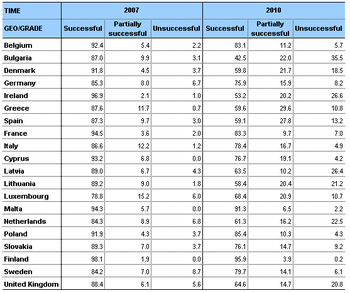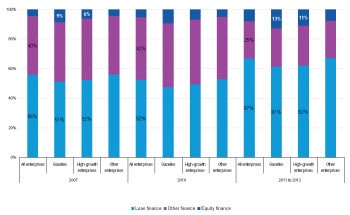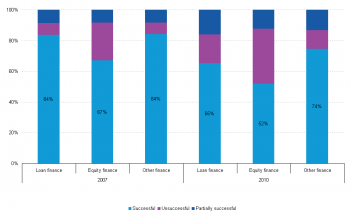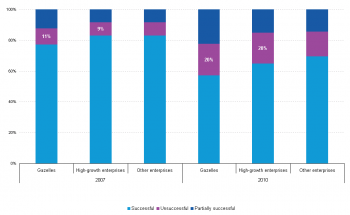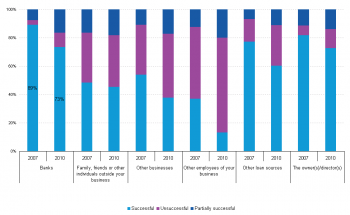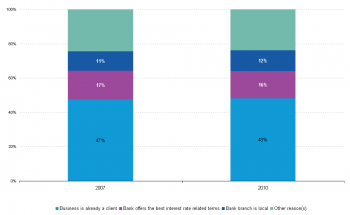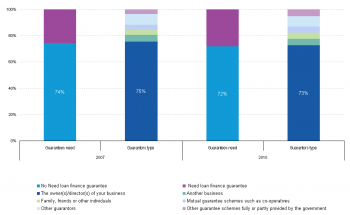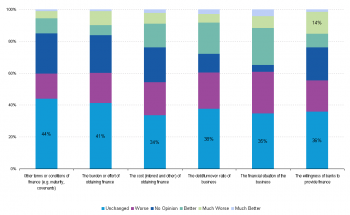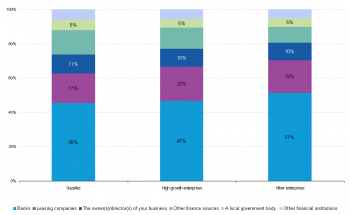Archive:Access to finance statistics
- Data from September 2011.
Authors: Elisaveta Ushilova and Manfred Schmiemann (Eurostat - Structural business statistics Unit)
This article discusses recent statistics on access to finance for small and medium-sized enterprises (SMEs) in the European Union (EU) collected by a survey coordinated by Eurostat. It analyses the consequences of the crisis by comparing data for 2007 and 2010 and sketches the outlook for the coming period, 2011 to 2013. External finance is essential for all enterprises to increase productivity, innovate, conquer new markets or, more generally, to create employment and wealth; easy access to finance is especially crucial, however, for SMEs.
Data broken down by NACE and by type of firm (high-growth versus gazelle versus other SMEs) show that
- more than half of surveyed companies did not seek finance of any type in 2007 and 2010, although a significant increase of finance need is perceived for the next three years;
- loans remain the most requested finance type for the whole period 2007-2013;
- success rate in obtaining finance severely decreased when comparing 2010 to 2007, indicating a credit crunch;
- reasons given for partial success or failure to obtain loans diverge: lack of own capital of loan seekers according to banks, too steep interest rates according to loan seekers themselves;
- ‘being already a client’ was the main reported reason for choosing a particular bank for a loan in both 2007 and 2010;
- need of a guarantee in obtaining loan finance is rare;

- 35% of all surveyed companies considered the financial situation of the business unchanged between 2007 and 2010, yet success rates for finance sought severely declined;
- banks remain the most envisaged finance source for the period 2011-2013;
- companies cite the general economic outlook as the most likely factor limiting business growth between 2011 and 2013 – despite an optimistic view on future access to finance.
Main statistical findings
Survey results highlight the challenges in obtaining funds for small businesses during a financial and economic crisis. They may also provide ideas for policy makers and other decision takers on more innovative and flexible ways of providing financial services for SMEs. The information could also be used to identify growth obstacles, in particular financing gaps for small and young high growth enterprises.
Seeking finance
Most SMEs do not need external finance, but some sectors in the economy have higher needs than others, and the overall finance need will significantly increase in coming years
In 2007 and 2010 a majority of SMEs did not seek external finance, but in 2010 there was a slight increase of seeking all finance types. The projection for 2011-2013 showed that more than half of all surveyed enterprises are likely to need finance. For the same period, gazelles and other high-growth firms are more likely to seek funding, respectively 59 % and 57 % (Figure 1). Enterprises in industry and construction are the most likely to request funding in the next tree years; 55 % for Sections B to E and 54 % for Section F, followed by those in Sections G to N, except J, K, M (services) – 48 % and Section J (ICT services) – 46% (Figure 2).
Finance types sought
Loans remain the most important finance type, and high-growth firms will likely need more loans than equity finance in coming years
Over the entire observation period (reference point in 2007 and perceptions for 2011-2013) loans remain the most desired finance type, and their need will increase in the years to come. 'Other finance' was the next important finance type sought, but need for it will decrease considerably, by 15 percentage points comparing statements about the year 2007 and projections for 2011-2013. Projections for the period 2011-2013 also indicate an increase of 10 percentage points in the need for loans by gazelles and other high growth enterprises, and for such fast growing firms the projected need for 'Equity finance' will nearly double (Figure 3).
Success rate in obtaining finance
Dramatic decrease between 2007 and 2010
In 2007, 84% of firms were successful in obtaining loans, while for equity finance the success rate was 67 %. However, by 2010 the success rate decreased substantially, respectively by 19 percentage points for loans, 15 percentage points for equity and 10 percentage points for other finance. In the same year, the combined rate of only partially and unsuccessful finance requests dramatically increased for every finance type, and especially for loans (Figure 4). Data on the success rates for the various finance types provide evidence that in 2010 small firms often struggled or failed to convince financial institutions to invest in them or lend to them. As a whole, the rate for partially successful and unsuccessful requests doubled in 2010 compared with 2007. This was especially true for gazelles and other high growth enterprises, where the rate increased from 11 % and 9 %, respectively, in 2007, to 20 % for both groups of firms in 2010 (Figure 5). Banks were the most targeted finance source in obtaining loan finance, and had the most significant success rate, which, however, decreased by 16 percentage points in 2010 compared with 2007 (Figure 6).
Reasons for partial success or failure to obtain loan finance
Lenders look for security, loan seekers for low interest rates
For both reporting years the main reasons given by banks to refuse requested loans from SMEs were: 'Poor credit rating', 'Lack of own capital' or 'Insufficient collateral'. Other lenders, next to 'No reason given' and 'Other reason', also indicated the same rejection reasons as banks.
In the opinion of the loan-seeking businesses, in 2007 the most cited reason for not obtaining a loan at all, or for obtaining it at less desirable conditions than sought, was 'High interest rates', accounting for almost half (45 %) of the cited reasons for not being fully successful in loan applications, which fell by 10 percentage points in 2010 – perhaps indicating lowered interest rates in the crisis (Figure 7).
Reasons for choosing a particular bank for a loan
Being a client already was by far the most important reason for loan seekers to resort to their finance source
Banks were the most common source to obtain loan finance in every participating Member State. Survey respondents cited ‘Business is already a client’ in almost half of all cases, making it by far the most important reason to choose a particular bank: 47 % in 2007, and 48% in 2010 (Figure 8).
Guarantee needs and guarantor types in obtaining loan finance
Only seldom guarantees are needed, but if so, owners/directors of the loan seeker usually guarantee
Despite the challenges in obtaining finance, especially in 2010, evidence showed that the need for a guarantee was not the main reasons for small businesses failing to get finance. Almost three quarters of the surveyed companies reported no need of a guarantee in obtaining loan finance in 2007, and the percentage slightly decreased by 2 percentage points in 2010. As for who guaranteed, nearly three in four of the respondents indicated 'The owners/directors of the businesses' as the most common guarantors (Figure 9).
Perceived changes in the financial situation between 2007 and 2010
A mixed picture
For the period between 2007 and 2010, 35 % of all surveyed enterprises reported the financial situation of the business as 'Unchanged'. The willingness of banks to provide finance was deemed to be "Much worse" by 14% of respondents for the period between 2007 and 2010 (Figure 10). This is a very subjective impression, since this question was replied by all surveyed enterprises, the majority of which did not seek finance at all – but it correlates positively with the decline in success rates for those that did.
Envisaged finance sources between 2011 and 2013
Banks and leasing companies need to be prepared to be addressed as financiers for SMEs
For all type of enterprises the most important finance source for the next years remains 'Banks', interestingly followed by 'Leasing companies'. 'The owner(s)/director(s) of the business' are likely to be another possible source. Relatively a few businesses expect to receive finance from 'A local government body' - only 5 % cited it as a possible finance source (Figure 11).
Most important factors limiting business growth between 2011 and 2013
Access to finance is not the biggest concern for enterprises: price competition and limited demand worry many businesses
After passing through the credit crunch in 2008 and 2009 (notwithstanding the fact that it might not be over in all countries), access to finance does not seem to be the biggest concern for small businesses. Only 4 % of companies cited 'Not enough financing' among the factors that should limit the growth until 2013 (this respondent population again includes those that did not, and will not, seek external finance). About one-fifth (22 %) of enterprises cited the 'General economic outlook' as a constraint, whereas 16% cited 'Price competition/small margins', and 12 % 'Limited demand in the local/domestic markets'. (Figure 12)
Data sources and availability
The Eurostat survey on access to finance was conducted in 2010 and comprised a sample of about 25 000 enterprises in the 20 participating countries: Belgium, Bulgaria, Cyprus, Denmark, Finland, France, Germany, Greece, Ireland, Italy, Latvia, Lithuania, Luxembourg, Malta, Netherlands, Poland, Slovakia, Spain, Sweden, and the United Kingdom.
The survey covered small and medium-sized enterprises in terms of employment (with 10 to 249 persons employed).
Information was collected for two significant observation moments:
- 2007 - considered a reference point before the financial crisis;
- 2010 – considered a year signaling the end of the financial crisis, at least in some Member States.
Data about the perception of finance need, envisaged finance types and sources, purpose of the finance and potential obstacles to business growth was also compiled for the coming three years (period from 2011 to 2013).
The target population for the survey was the population of enterprises that fits all of the following characteristics:
- classified to NACE Rev 2 codes B to N, but not to code K (financial services);
- independent, i.e., not a subsidiary of another business, either in the same Member State or foreign;
- has existed at least since 2005;
- had between 10 and 249 persons employed in 2005;
- active in 2008;
- has at least 10 persons employed at the reference period in 2010 – there is thus an inherent bias on surviving firms.
Context
Access to finance is crucial to business success and an important factor for economic growth in Europe, especially in view of any past or future economic crisis and the ensuing possible credit crunch. The purpose of this survey was to examine where there may be constraints on the availability of finance, and how those may be changing; the need for finance (loans, equity and other) in the future, for example to promote growth, and the sources from which businesses would wish to obtain this finance, and an outlook on barriers to business growth in the future.
Data are collected under Regulation 97/2009 of 2 February 2009. Regulation 295/2008 made provision for a flexible module “for the conduct of a specific and limited ad hoc data collection of enterprise characteristics”.
Political backdrop
External finance is essential for all businesses that strive to increase productivity, foster innovation, conquer new markets, or, in general, seek to create employment and wealth for the wider national and international benefits. Affordable and appropriate access to finance is an important issue not only for start-ups and growing companies, but also for existing ones, expanding their operations or staying competitive in their markets. Easy, burden-free access to finance is therefore a crucial political goal, especially benefitting small and medium-sized enterprises (SMEs) with their specific finance needs, due to their shares in terms of number of enterprises, turnover and employment in the business economy.
To shed light on these issues Eurostat, in consultation with its users for business statistics, i.e., European Commission policy departments, the OECD, the European Investment Fund (EIF) and the European Central Bank (ECB), has coordinated a business survey to obtain information on the access to finance of small and medium-sized enterprises (10 to 249 persons employed – thus excluding micro enterprises, for burden reasons and in order not to create a bias towards businesses that may mainly finance themselves internally). Data on reference years 2007 and 2010 plus an outlook of businesses what to expect for the years 2011 to 2013 were obtained and can be broken down by NACE and by type of firm: high-growth, gazelle, and other SMEs.
Purpose of the survey
The purpose of the survey was to:
- examine where there may be constraints as regards the availability of finance, and how those may be changing;
- provide evidence on the need for finance (loans, equity and other) in the future, for example to promote growth;
- identify the sources from which businesses would wish to obtain this finance;
- obtain business leaders' perceptions where they see development constraints in the years to come.
The results give information on important financing issues such as development of finance need, range of finance types and sources sought, success rates in obtaining finance, reasons for choosing a particular financial institution, reasons for lack of success in obtaining finance, envisaged finance sources in the future, and the most important factor limiting business growth.
Further Eurostat information
Publications
Database
Structural business statistics (sbs), see:
- Access to finance statistics (acf)
Methodology / Metadata
- Access to finance (ESMS metadata file - acf_esms)
- Eurostat-OECD Manual on Business Demography Statistics
- Methodology and Questionnaire
Other information
- Regulation 97/2009 of 2 February 2009 implementing Regulation 295/2008 concerning structural business statistics, as regards the use of the flexible module
- Regulation 295/2008 of 11 March 2008 concerning structural business statistics
External links
- European Central Bank - Survey on the access to finance of SMEs in the euro area
- European Commission - Enterprise and industry - Access to finance - Data on access to finance
- European Commission - Enterprise and industry - Access to finance - Enterprise finance index
See also
Notes
- ↑ The information presented is based on the combined, grossed-up results of the total of the 20 participating countries: Belgium, Bulgaria, Cyprus, Denmark, Finland, France, Germany, Greece, Ireland, Italy, Latvia, Lithuania, Luxembourg, Malta, Netherlands, Poland, Slovakia, Spain, Sweden, and the United Kingdom.
